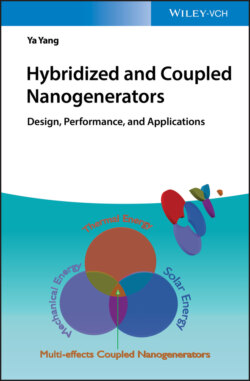Читать книгу Hybridized and Coupled Nanogenerators - Ya Yang - Страница 29
2.3.1.3 Elasto‐aerodynamics‐Driven TENGs
ОглавлениеUnder high wind speed, enhancing the stability of the devices is very important because of complex factors, such as buffeting, vortex shedding, galloping, and flutter. There are some natural mechanical problems in the vibrating plate‐based TENGs due to a combination of bending and torsion. To increase the stability and output performances of TENGs, elasto‐aerodynamics‐driven TENG was developed, which consists of a Kapton film, two PTFE films, and Cu electrodes (Figure 2.5a) [34]. Figure 2.5b shows the front view of the device.
The working mechanism of the elasto‐aerodynamics‐driven TENG is schematically depicted in Figure 2.5c. Owing to couple triboelectrification and electrostatic induction, alternating electrons can flow between Cu electrodes. At the initial state, the TENG is in static condition, resulting in no output signals. When the Cu electrode makes contact with the top PTFE film because of wind‐induced vibration, electrons are transferred due to different triboelectric series, and their surfaces will respectively form positive and negative charges. When the distance between the Cu electrode and the PTFE film increases under the external force the balance is broken, leading to the generation of the current signal through an external load. The electrostatic‐induced charges disappear when a new balance is built between the Cu electrode and the PTFE film. In this state, the surface of the Cu electrode forms positive triboelectric charges, and the surface of the bottom PTFE film forms negative charges. Subsequently, the charges on the top electrodes and the bottom electrodes can flow respectively in the external circuits due to the electrostatic induction.
